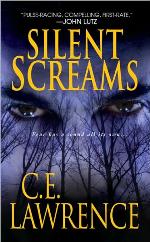All Faculty Excerpts
Silent Screams
 Gotham teacher Carle Bugge (writing under the pseudonym C.E. Lawrence) has just seen the publication of her novel Silent Screams. It’s a thriller about a criminal profiler, Lee Campbell, on the hunt for a killer who leaves women dead and mutilated in churches around Manhattan. The killer, of course, is diabolically clever, and it doesn’t help that Campbell has only recently recovered from a nervous breakdown.
Gotham teacher Carle Bugge (writing under the pseudonym C.E. Lawrence) has just seen the publication of her novel Silent Screams. It’s a thriller about a criminal profiler, Lee Campbell, on the hunt for a killer who leaves women dead and mutilated in churches around Manhattan. The killer, of course, is diabolically clever, and it doesn’t help that Campbell has only recently recovered from a nervous breakdown. Publisher’s Weekly calls it a “dark, intriguing thriller.” Take a peek at the book’s opening, if you dare:
______________________________________________
Lee Campbell stood looking at the naked body draped over the altar of the church. The girl’s delicate white skin was pale as the cold marble floor beneath his feet, in stark contrast to the vivid red wounds slashed across her torso and the purple bruising around her neck.
Come on, Marie, talk to me,” he whispered. He bent down over her, looking for petechial hemorrhaging in or around the eyes, but could find none. The lack of patterned abrasions meant there had been no ligature. “So he used his hands,” he murmured. Some strangulation victims had no sign of injuries at all, so he was grateful for the bruising around her neck— pronounced enough to suggest that this, and not the slash wounds, was the cause of death. He thought about what her last moments were like: eleven pounds of pressure for ten seconds could cause unconsciousness, and thirty pounds of pressure, for four or five minutes, would result in death.
He observed the blue creeping into her lips, the porcelain smoothness of her dead cheeks. At least he left her face alone. He had always found it odd that strangulation victims sometimes looked strangely peaceful, with all of life’s pain, suffering, and uncertainty behind them now. Lee felt a stab of envy in his stomach, and a warning sounded in his head. He could not allow himself to linger over such thoughts. He closed the door of his mind to the desire to be where this dead girl was now, to be done with mad dance of life and its many trials.
But of course, there had been nothing peaceful about her death. His eyes fell on the jagged letters carved into her naked torso: Our father who art in heaven. The O encircled her left breast like a red halo, the blood droplets symmetrical on her pale flesh. For some reason, he was reminded of a red and white hula hoop his sister had as a child. The writing was uneven and slanted downward— a job done in haste, he concluded, by a killer who was not yet comfortable with this part of his work.
The blood had dried and was caked in little mountainous crusts of crimson on her pale skin. The word “Heaven” was cut into her abdomen, just over the light dusting of dark pubic hair on her pelvis. There was little excess blood around the altar, and no signs of struggle, suggesting that she was killed elsewhere
What happened to you?” Lee whispered. “Who did this to you?” Even at a whisper, his voice echoed and fluttered, ghostlike, through the tall stone columns of the chapel’s interior. Lee had never been on the Bronx campus of Fordham University before, and he was surprised by the size of the campus chapel. But then, Fordham was a Catholic school—in fact, the college seminary was just across the quad.
Lee studied the dead girl’s face, waiting for the eyes to flutter open, and realized with a start that she resembled his sister—the same curly dark hair and white skin. He had often imagined seeing Laura like this, wondering what he would do or say, but her body had never been found. And so that encounter hung in suspended animation, waiting for him in some near or distant future. He looked down at Marie, cold and unmoving upon the altar, not a line creasing her smooth cheeks, her youth a rebuke to the person who had squeezed the life from her body. Lee was relatively new to such intimacy with the dead, and it held a fascination he knew was not entirely healthy.
But Leonard Butts, the Bronx detective assigned to this case, had no such fascination, nor was he of a sentimental turn of mind.
"Okay, Doc,” he said, approaching Lee. “You ‘bout done there? ME’s here, and we’d like to get the vic downtown ASAP.
. . . Instead of the handsome, regular features of a stereotypical Irish cop, the detective had a decidedly uneven face, with flaccid jowls, a bulbous lower lip, small eyes, and a complexion like an unkempt gravel road. There was no discernible change in the thickness where his skull began and his neck ended; his neck rose in an unbroken line up to the top of his head, crosshatched tanned skin fading into gray hair stubble. Lee was reminded of the mesas he had seen in Arizona. To top it off, Butts was short and thick—Elmer Fudd in a trench coat.
___________________________________________________________
Reprinted by permission of Kensington Publishing. For more information on C.E. (AKA Carole Bugge) and her book, visit www.celawrence.com.
